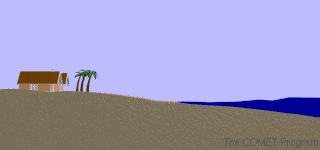
Source: Storm Surge, Weather Wiz Kids
Hurricanes usually weaken when they hit land because they are no longer being fed by the energy from the warm ocean waters. However, they often move far inland, causing a lot of damage.
The wind speed of most hurricanes ranges from 120 km/h to 150 km/h, but some hurricanes produce winds that can reach speeds as high as 300 km/h. These winds can cause an enormous amount of damage by knocking down trees and telephone poles. They can also damage or destroy buildings and houses.
While the strong winds cause a great deal of damage, most hurricane damage is caused by flooding associated with heavy rains and storm surges. A storm surge is a wall of water that builds up over the ocean due to heavy winds and low pressure. The wall of water gets bigger and bigger as it nears the shoreline. It is at its greatest height when it crashes onto the shore. Depending on the hurricane's strength, the storm surge can be 1 meter to 8 meters high and 65–160 km long. The animation below shows a storm surge.

Source: Storm Surge, Weather Wiz Kids
![]() Hurricane Ike hit the Galveston shoreline on September 13, 2008. It had 110 miles per hour winds and 10 to 12 foot storm surges. Watch this video below to see some of the damage that Ike caused.
Hurricane Ike hit the Galveston shoreline on September 13, 2008. It had 110 miles per hour winds and 10 to 12 foot storm surges. Watch this video below to see some of the damage that Ike caused.
Source: Hurricane Ike: Devastation in Houston, VOAvideo, YouTube